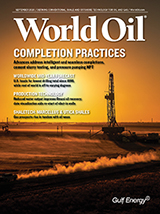Issue: September 2020
Global Mid-Year Forecast
The catastrophic demand decline initiated by coronavirus lockdowns significantly damaged the U.S. oil industry, with oversupply, historically low storage capacity, and low prices. Operators responded by stacking rigs and shutting-in production.
As the world holds its collective breath over Covid-19, Canada’s oil patch has shifted drastically to pure survivalism. Most measuring sticks of industry health show historic lows, while lack of market access continues to hurt producers.
Most regions will see significant reductions in activity, although the Middle East and China seem to be faring better.
Features
As E&P operators recover from Covid-19, digital transformation has brought new levels of well analysis not possible before. The latest in subsurface data visualization brings disparate data sets together—from oil price to well characteristics—to give operators ultimate confidence in their recovery plans.
Effective management of reservoir sweep, with regard to wellbore influx, is an inherent issue affecting horizontal well lengths. As an active, self-regulating technology, autonomous inflow control devices respond to viscosity changes to choke water and gas more effectively, increasing production and sustainability.
Gas Prospects Rise in Concert with Oil Woes
Latshaw Drilling and Double Eagle Energy hosted a rig site event, where President Trump reiterated that oil and gas E&P is a centerpiece of his energy and economic policy.
Integrating imaging methods reveals sub-seismic features in the reservoir section and leads to a more accurate structural model of the subsurface.
The benefit of complex wellsite fluid systems can be gained more readily with a total fluids management approach. The author describes such a system, its various components and how they work together to deliver value using a unified approach.
Special Focus
The future lies in integrating the drilling, completion and production phases. This life-of-well approach will deliver the next-generation well intelligence needed to reduce the cost of asset ownership, while maximizing profitability.
As the industry shifts to conducting operations in 2020’s climate, thriving now depends on minimizing NPT and operating costs, more than ever.
Pursuing revolutionary transformation will redefine how we work and catapult the oil and gas industry forward
Gel Strength Development is critical in the evaluation of completion cement slurry design. This article explores the evolution of both the Mechanical and Acoustic laboratory test methods for gel strength testing.
Columns
Energy transition taking shape
Cloudy, but plowing ahead
The best technology is often boring
Exploration is near zero, not just because of demand
An historical year in many respects
We’re here! Now what?
Resources



